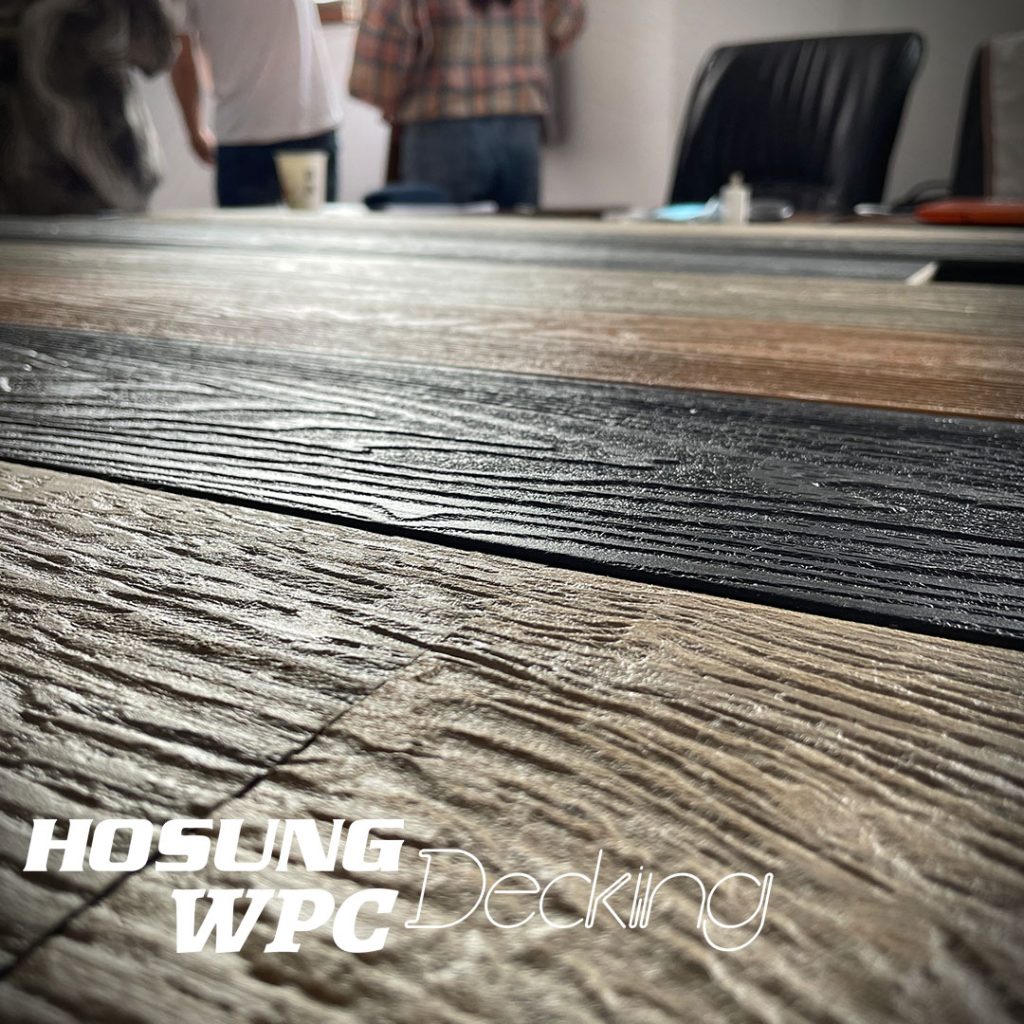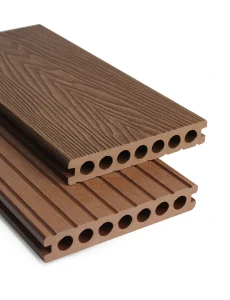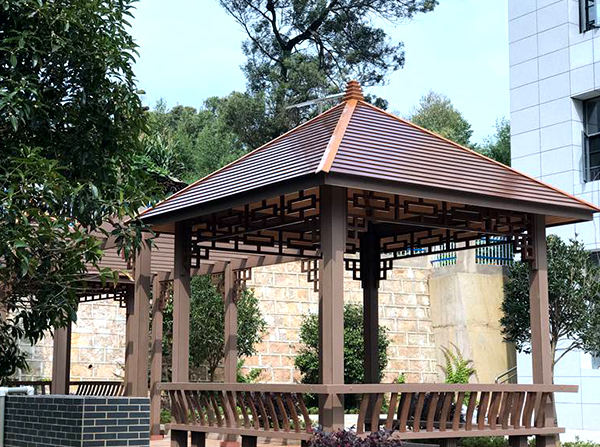Ultra Composite Decking: In today’s era, the use and remodeling of outdoor space is becoming more and more important to people. A comfortable, beautiful and functional outdoor deck or patio not only enhances the quality of life of a family, but also increases the market value of a home. With the development of nowaday’s technology and the rapid changing of consumer needs after the pandemic, traditional wood timber decks are gradually revealing their shortcomings, such as perishability, the need for regular maintenance and environmental impact. Against this backdrop, Ultra Composite Decking was born, quickly capturing the market with its unique material benefits and design aesthetics.
Ultra Composite Decking is a composite material made from recycled plastic and wood fibers through a high temperature and high pressure process, which combines plastic’s duribility with the natural beauty of wood. The emergence of this material not only solves the problems that associats with traditional wood decking, but also provides more options and possibilities for outdoor decoration. This article will take an in-depth look at Ultra Composite Decking’s key features, types, cost considerations, and comparisons to other decking options to help readers fully understand this innovative product.
Table of Contents
Key Features of Ultra Composite Decking
Durability
One of the biggest selling points of Ultra Composite Decking is its superior durability. Since its main component is plastic, this makes it extremely resistant to corrosion, mold and cracking. Whether it’s in the hot sun or the cold rain or snow, Ultra Composite Decking will maintain its consistent performance and appearance. This kind of hallmark is especially important for homeowners living in extreme climates because it reduces the frequency and cost of replacing or repairing the deck.
Low Maintenance
Ultra Composite Decking requires little maintenance compared to traditional lumber decks. While lumber decks require regular sanding, staining, and preservative treatments, Ultra Composite Decking requires only occasional cleaning to maintain its fresh, new look. Not only does this save the homeowner time and money, it also makes the deck more environmentally friendly because it reduces the use of chemicals and the production of waste.
Resistance to Weather and Pests
Another remarkable characterization of Ultra Composite Decking is its strong resistance to weather and pests. Due to its non-organic material composition, it will not attract termites or other harmful insects. It also won’t expand or contract due to changes in humidity, which is especially important in rainy or humid areas. This kind of property: easy to clean and mantain, makes Ultra Composite Decking a much more ideal choose for those who are eager for minimizing WPC decking’s long-term maintenance efforts and costs than decking made from other materials.
Environmental Benefits
Ultra Composite Decking also excels when it comes to the environment. It is manufactured using recycled plastic and wood fibers, which helps reduce pressure on landfills and promotes recycling of resources. While the manufacturing process may consume energy, overall, Ultra Composite Decking has a much lower environmental footprint than traditional lumber decks that require ongoing deforestation.

Types of Ultra Composite Decking
Veranda Ultra Light Composite Decking
Veranda Ultra Light Composite Decking —— a decking material designed and tailored to become lightweight. The core technology, which utilizes an advanced lightweight that allows the deck to be significantly lighter, which is ideal for structures that can’t handle excessive loads or temporary structures that need to be moved. Much more,the special surface treatment makes sure that durability and aesthetics are not sacrificed, even as weight is reduced.
Ultra Shield Decking
Ultra Shield Decking is another popular line of Ultra Composite Decking that is known for its excellent weather and abrasion resistance. Featuring a special protective layer that protects against UV radiation and harsh weather, maintaining long-lasting freshness and color stability, Ultra Shield Decking is ideal for use in outdoor environments that require prolonged exposure, such as poolside or rooftop decks.
Customization Options
In addition to the standard line of products, many manufacturers offer customization, allowing homeowners to choose colors, textures and even shapes based on their specific needs and aesthetic preferences. This high degree of customizability allows Ultra Composite Decking to meet a variety of design requirements and personal styles.
Cost Considerations
Impact Factors
Cost is a factor that should not be overlooked when selecting Ultra Composite Decking. Price is usually influenced by a number of factors, including the quality of the material, the complexity of the design, the quantity purchased, and the cost of shipping. High-quality Ultra Composite Decking tends to offer better performance and a longer lifespan, so its price will be correspondingly higher. Much more than what had mentioned before, complex designs may require more fabrication and installation work, which adds to the overall cost.
Pricing of Ultrashield decking
Ultrashield decking is typically priced in the range of $25.00 per square foot, a price range that reflects its balance of durability and aesthetics. While the initial investment may be higher than some other decking options, its long-term durability and low maintenance costs make it a good value overall.
Price information for Ultradeck composite decking installation
Ultradeck composite decking installation is priced at about between $35.00 and $50.00, this price includes the cost of materials and professional installation. It is important to note that this price may vary depending on the area, design, and size of the project.
Installation Costs
In addition to the cost of materials, the cost of installation is one of the most important factors in determining the total cost. This includes labor costs, tool rental fees, and possibly design fees. In general, composite decks are more complex to install than traditional wood, and therefore may require more specialized skills and time commitment.
Comparison to Other Decking Options
Pressure Treated Wood
Pressure-treated lumber is a common deck material that is chemically treated to resist rot and insect infestation. However, this treatment can have a negative impact on the environment and the chemicals may leach out into the soil over time. In addition, even after treatment, the wood still requires regular maintenance and replacement.
Traditional Vinyl Decking
Traditional vinyl decking is favored by many homeowners for its low cost and easy maintenance. However, it often has a less natural look and feel than wood and can suffer from warping or fading in extreme temperatures. In contrast, Ultra Composite Decking offers a solution that is both environmentally friendly and aesthetically pleasing.

In summary, Ultra Composite Decking is an ideal choice for outdoor remodeling projects due to its durability, low-maintenance, environmentally friendly properties, and strong resistance to weather and pests. While its initial investment may be higher than some other options, it can be considered a cost-effective solution given its long-term durability and low maintenance costs. Ultra Composite Decking is certainly an option to consider for those looking for a high-quality, sustainable and attractive outdoor flooring. Consider Ultra Composite Decking for future outdoor renovation projects and add a touch of beauty and comfort to your home. For more information, please contact HOSUNG WPC.








